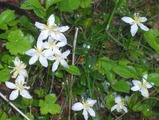360401 Coptis trifolia (L.) Salisb.
Distribution
Western Alaska: Presence uncertain
Hudson Bay - Labrador: Scattered
Western Greenland: Scattered
Eastern Greenland: Scattered
Southern Arcti Tundra: Rare
Shrub Tundra: Frequent
Bordering boreal or alpine areas: Frequent
- Salisb., Trans. Linn. Soc. London 8: 305 (1807). - Helleborus trifolius L., Sp. Pl.: 558 (1753). Described from "Canada, Sibiria". Lectotype (LINN): Herb. Linn. 718.8, leg. Steller? (Reveal in Jarvis et al. 2005: 469).
- Anemone groenlandica Oeder, Fl. Dan. 4, 10: 5, t. 566 (1770). Described from Greenland. - Coptis groenlandica (Oeder) Fernald, Rhodora 31: 142 (1929). - Coptis trifolia subsp. groenlandica (Oeder) Hultén, Fl. Aleut. Isl.: 192 (1937).
2n=
18 (2x). - Far East (N, S), Canada, U.S.A. - Several reports, one from Quebec for C. groenlandica.
Geography: Amphi-Pacific - North American: ALA? CAN GRL.
Notes: Elven and Murray: Hultén (1968a) mapped one locality for Coptis trifolia near Nome on the Seward Peninsula in western Alaska. The records (one literary, one specimen) need confirmation as this species otherwise is temperate in the Pacific regions.
There has been some discussion among North American botanists whether a C. groenlandica is separable from C. trifolia s. str. (Taylor and Mulligan 1968; Ford 1997b). Fernald (1929a) and Scoggan (1978c) reported the following diagnostic characters for C. trifolia s. str. vs. C. groenlandica: leaflets sessile-subsessile vs. short-stalked; sepals obtusish and up to 4 mm broad vs. acutish and up to 3 mm broad; petals about as long as broad vs. broader than long; and follicles less than 5 mm long vs. up to 9 mm long. These seem to be sufficient differences for racial recognition but inspection of material (ALA, O) from Greenland, Quebec, Pacific Canada, Alaska, and Pacific Asia did not confirm them. Leaflets are just as short-stalked in the Pacific regions as in the Atlantic ones (more sessile perhaps just in some Aleutian plants). Sepal shape is the same in both regions but eastern plants generally have smaller sepals, range 1-1.7 mm in Greenland, 1.7-2.4 mm in Quebec and Labrador, 2.1-2.9 mm in Pacific Canada, and 2.2-3.2 mm in the Aleutian Islands. There was no difference in whether the petals were distinctly clawed or not and no distinct difference in petal size. Follicles were generally longer in Pacific Canada and Asia (6-8 mm) than in the Aleutian Islands (5.5-6.2 mm) and shortest in Greenland (ca. 3.5-4 mm), opposite to what was stated by Scoggan. Seed shape (quadrate in C. trifolia vs. rounded in C. groenlandica) did not differentiate. We do not recognize races.
Higher Taxa
- Coptis [3604,genus]
